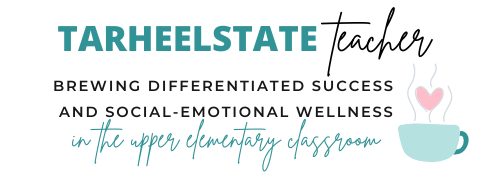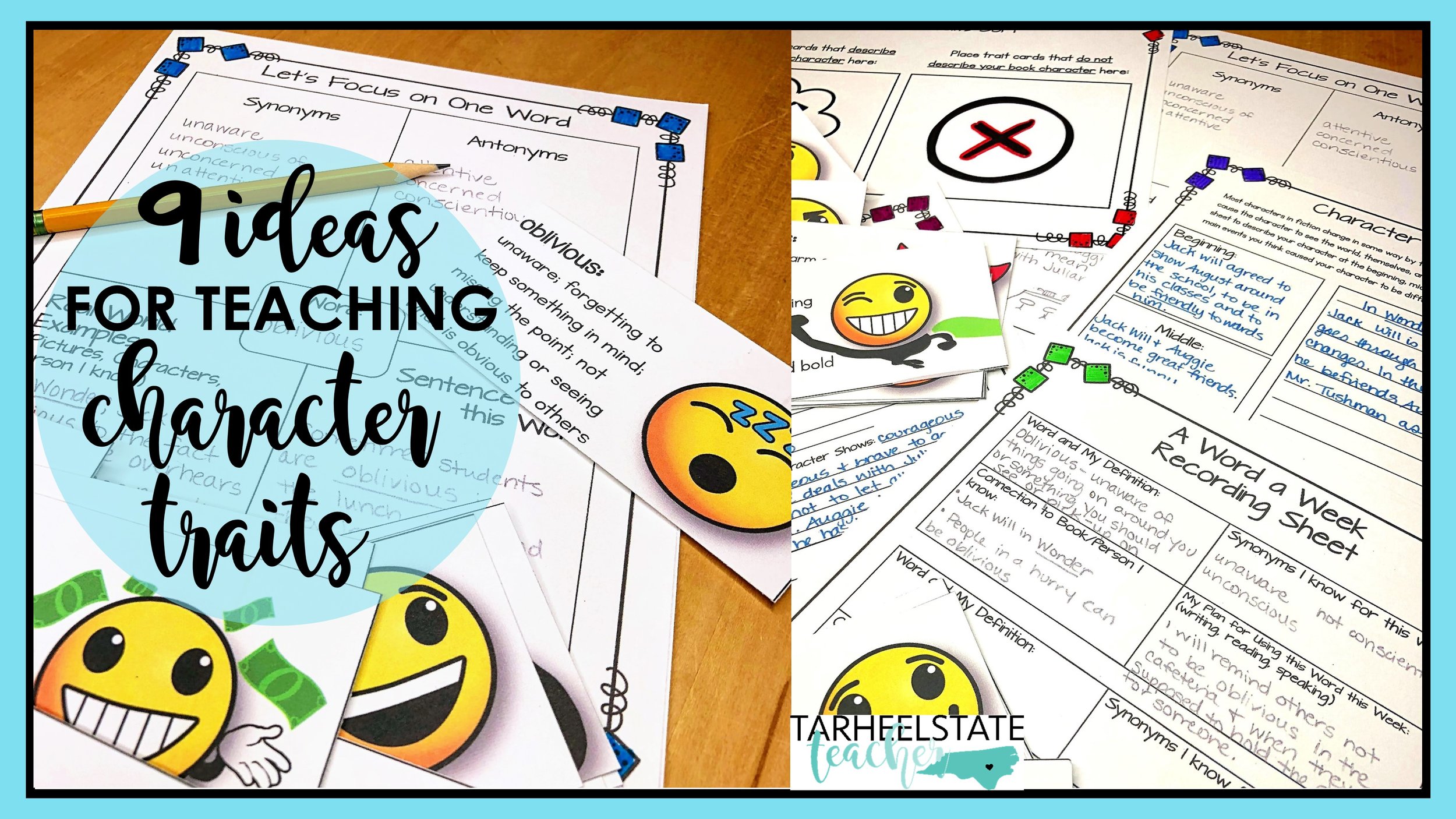A Lesson Fail and 9 Ideas for Character Traits
Looking for ideas and activities to teach your character trait lessons? Wanting to find better ways to increase your students’ vocabulary and ability to describe characters? Well, read all about my “lesson fail” and the “better” strategies I implemented that helped my students make great gains in improving their ability to describe characters…here we go!
I once taught a guided reading lesson to a group of 4th and 5th graders on describing characters in a story. The plan was for us to read through the book (for the third time on day three of guided reading with this group), look at the character’s actions, and decide how we would describe them. With a group of five children, I expected that we would brainstorm a few words quickly and I could focus the lesson on justifying our character traits with evidence from the text.

Do you know where this story is going? Do you recall yourself attempting to teach the same lesson at some point in your classroom? You can laugh with me. It doesn't hurt too bad.
Back to the story, in case you are not recalling your own memories at this moment… I was quickly dismayed at the lack of vocabulary that my students were able to generate. I heard characters being described as nice, kind, mean, good, and bad.

Now, to add some background information to this story, I was teaching a reading intervention group. These students had been identified specifically for having low language skills. No one was ESL or ELL, but their ability to communicate their thoughts and retell stories through the use of grade-level appropriate vocabulary was very low. Our routine was to read the same short story each day for a week focusing our attention on different aspects of the story with each reading. And toward the last few days of the week, we spent time discussing the story by focusing on one tiny literary aspect. Students basically had the stories memorized, so the rest should be easy, right? FACE PALM!
However, after this lesson fail, I realized that my readers would not be able to come up with quality vocabulary without a little scaffolding from their teacher! And to tell the truth, even students reading on grade-level sometimes have difficulty coming up with good words COLD TURKEY, am I right?!? Thesaurus PLEASE!!!
I quickly picked myself up off my kidney table and came up with a strategy. I began developing a list of words, creating definitions, and providing students with pictures that would trigger the meaning of the words. I printed a set of these vocabulary word cards to use during my guided reading lessons. I would pull out a handful prior to each lesson, looking for words that DESCRIBED a character in the story AND words that were ANTONYMS of how I would describe the characters in the story.

Can you imagine?!?!? Students were SO MUCH MORE successful! And you know what happened as the weeks continued? They started INTERNALIZING the words I had introduced to them and firing off new words not even included in my word set.
Later, I began using these character traits and definitions in reader's workshop with the whole group when I taught lessons on describing characters. I used them in writer's workshop to support my minilessons focused on brainstorming ideas for personal narratives that focused on strong emotions and feelings.
I printed all of the character traits on cardstock and made a border of character traits on the main wall of my classroom. You can find my 48 character traits in my store. {This summer, I created an EMOJI style set, which you will see in many of the pictures below.}
Some of the words I used may seem pretty basic to you or for some of your students but I have found that having even a simple list of words works magic in helping myself and students generate more sophisticated vocabulary for describing characters.
Having this list helps us choose great words and generate better ones because we are not starting from scratch! No face palms for you, because you can learn from my mistakes!
Today, I've got 9 Ideas for How You Can Get Your Students Practicing and Using Character Traits to Increase their Vocabularies for Describing Characters, Traits, and Feelings
1) VOCABULARY DEVELOPMENT WITH “A WORD A WEEK”:
Begin a “Word a Week” Routine. Display the character trait/adjective at the beginning of the week. Use a Frayer Model (with four quadrants) or other recording sheet for students to keep up with the words they have learned and to guide aspects of your word explorations. You can focus on one word development topic each day, like synonyms, antonyms, real-world examples, and using the word in a sentence. Create an anchor chart with the four quadrants to display and allow students to add to it throughout the week as new ideas come to them.
I made two versions of the graphic organizer for "A Word A Week." One contains the 4 quadrants for the frayer model. In the second version, students' write a definition for the vocabulary word in their own words, list synonyms for the word, make a connection to a book character or person they know, and make a plan for how they will use the word in writing and speaking.
2) VOCABULARY DEVELOPMENT WORD KNOWLEDGE SORT:
Given a list of words, students can complete a word knowledge sort to have them think about their level of mastery for each vocabulary word. This would be a great strategy to use before starting your "Word a Week" routine. Then you could focus your attention on the words most students don't seem to know. This will allow you to get more bang for your buck as you teach them a new word each week.
3) LITERACY STATIONS:
Given a list of words, students can sort the words into positive/negative trait categories.
To apply the words to their own reading, they can sort the character traits by focusing on one character in their book and whether or not that character exhibits that trait.
4) READER’S WORKSHOP/INDEPENDENT READING:
Tie the character traits to students’ independent reading and your read alouds. Lead students to think about the character traits shown by the characters in their books (or class read alouds) and to consider how a character's personality (or character traits) have changed over the course of a story.

Addressing how characters change from the beginning to the end of a story is a great follow up lesson to just describing characters in general because characters typically go through changes in traits when we compare their actions and personalities at the beginning of a story to how they are at the end of a story.
In this example, I used Wonder by RJ Palacio and focused on how Jack Will transformed from friendly and supportive, choose to do something cowardly, and then was remorseful and a person with stronger character by the end of the story.
5) DESCRIBING CHARACTERS IN GUIDED READING:
Have a set of definition cards ready to use during guided reading. As you discuss characters in the story, allow students to choose words that describe the characters. Work hard to help them find words that MORE PRECISELY describe the characters’ personalities and actions. The definition cards CAN BE USED AS TRIGGER WORDS to help spark other descriptive words not included in the set. As your students get better and better at describing characters, vote or discuss which words they have generated most accurately describe the characters and which word they think is the best representation.
6) STRONG EMOTIONS/CHARACTER TRAITS IN WRITER’S WORKSHOP:
Choose 3-4 strong traits or emotions that lend themselves to writing personal narratives. Students can be prompted to brainstorm and write about a time when they exhibited those qualities {determined, courageous, embarrassed, and livid are always good choices for my students}.
Display the character trait/emotion on the smartboard. Get students talking about the emotion and sharing stories (whole group or with a neighbor). Have students title a journal page with the chosen emotion and ask them to list as many memories, moments, and ideas that come to mind for that emotion. Using different character traits in this manner gives students many story ideas to choose from when writing personal narratives.
7) CHARACTER TRAITS/ADJECTIVES BULLETIN BOARDS:
Create a bulletin board of emotions, character traits, adjectives, and descriptive words that students can refer to when describing characters during reading response activities and class discussions. You will be amazed at how their heads turn to refer to the words you have discussed. Expect students to come up with 3-4 descriptive words when describing characters in their own books and your read alouds.
8) Start the year with Character Trait Lessons:
Start by having students use character traits to describe themselves as a "Get to Know You" activity. Turn this into a fun activity by having students leave their names off their papers, numbering each student's sheet, and posting them in the hallway. Students can guess “who’s who” by reading one another’s sheets.
9) Use holidays/seasons as an opportunity for creative writing focused on character traits and adjectives.
Students can write stories about pumpkins, snowmen, Valentine hearts, shamrocks, or anything else you can think of. They can personify the item, choose a word, and write a story that shows the object acting in that way. My students have written about malicious pumpkins, jubilant snowmen, and compassionate Valentine hearts. Sometimes I focused the writing project on poetry, other times, they were required to write imaginative narratives with a strong beginning, middle, and end. To prepare for celebrating the writing projects, we decorate a pumpkin (real or a template printed on cardstock), make a snowman, or create a valentines heart to represent the character in the story and their trait. Our writing share and celebration turns into a bit of a classroom party and is an educational way to have some fun around different holidays.
So there you have it! I hope I've given you some fresh ideas for incorporating more work with Character Traits into your classroom. I do know this for sure--when you make vocabulary development a FUN and REGULAR part of your classroom routine, students start using the words you have shared with them. Sometimes they are playful or use the words to impress you, but they are really trying them out on their tongue or in their writing and learning how to use the words more precisely. It's a win-win.
I challenge you to teach your student some new words this year beyond your academic and content area vocabulary. It will be so rewarding!
What do you do to keep vocabulary development fun in your classroom? How do you teach character traits?
And most of all, were you nodding your head when I was talking about my lesson flop? Please let me know in the comments if I am NOT alone on this one!














